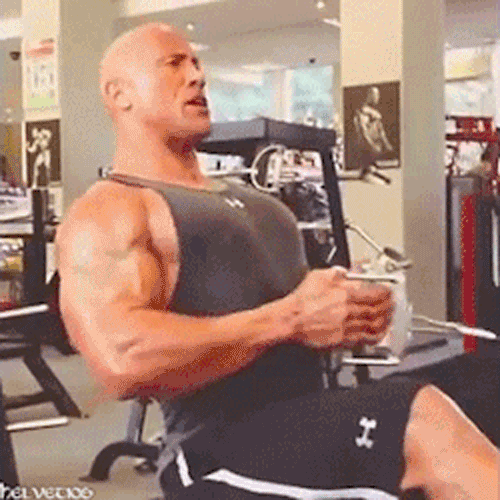What Is a Superset and How Can You Put It In Your Workout?
Even if you're not a self-professed gym rat, there's a certain allure to knowing your stuff at the gym. Yeah, you can pop in, jog on a treadmill, throw around some dumbbells, and #doyoursquats, but there's something empowering about designing your own workout and knowing exactly why you're doing every single exercise.
Chances are, if you've ever hit up a circuit-style workout class or had a personal training session (or just perused our strength training content on Shape.com), you've seen the word "superset" as part of the usual strength training routine. But as common as superset workouts might be, there's still a lot of confusion about what they are and how to do them right.

What Is a Superset?
At its very core, a superset workout is simple: alternating sets of two different exercises with no rest in between. For example, doing a set of biceps curls and a set of triceps dips, alternating until you've completed all the sets.
But when it comes to choosing exercises, things get a little hairy. "One of the biggest misconceptions is that you can throw two exercises together and you just smoke yourself, and that the goal is to get tired and sweaty," says John Rusin, physical therapist and strength and conditioning specialist. "Really, that's not the case. With an intelligently designed superset workout, you can have a goal in mind."
Put them together correctly and they can boost performance, build muscle and endurance, burn fat, and cut your workout time in half. Research shows that superset workouts burn more calories during and after your sweat sesh versus traditional resistance training, according to a study published in the Journal of Strength and Conditioning Research. But put them together incorrectly, and it can leave you with aches, pains, and injuries, or just an ineffective workout. (And we're not just talking about being sore.)
Different Types of Superset Workouts
For your basic gym-goer, calling these things the broad term of "supersets" will do the job. But if you really want to know what you're talking about (and impress everyone in the weight room), learn the different types of superset workouts and how they can help you achieve even more strength gains.
If you go by the super-specific definition, a true superset (antagonist superset) is when you're doing two exercises that target opposing muscles groups. Think: a biceps curl and a triceps extension. The main perk of adding these to your workout is that your muscles will recover faster in between sets. "When one muscle group is being contracted, its functional opposite relaxes, reducing the need of a break or rest time between exercises," says Edem Tsakpoe, head trainer at Manhattan Exercise Co. in New York City.
Then there's the compound set (agonist superset) where both exercises work the same muscle groups. Think: a push-up and a dumbbell bench press. These babies are the ones that will target one zone and get it burning, stat. "They're particularly useful for adding intensity and volume to a workout as well as focusing on particular muscle groups, and is the most demanding type of superset," says Tsakpoe. Some trainers even argue that you shouldn't call these superset workouts at all—just compound sets.
And there are also unrelated supersets, which is where the two exercises use totally different muscles groups. Think: lunges and biceps curls. "The primary advantage of this type of superset is that there is no loss of strength in going from one exercise to the other," says Tsakpoe. You can hammer out quality reps of both without feeling super fatigued.

How to Use Superset Workouts In Your Fitness Routine
The main draw of adding superset workouts to your exercise agenda is to get the biggest bang for your buck when it comes to time spent in the gym. "It increases the intensity of the workout while reducing the time it takes to execute the program," says Tsakpoe, this making it more effective. But beyond that, there are ways to use supersets to seriously jack up your training or focus on certain goals. Here, some superset workout ideas from Rusin.
Want to boost your PR? Try an activation-based compound set.
The idea is that before a big lift, you activate certain relevant muscles with a set of explosive exercises. Let's say you're trying to boost your squat performance. First, you do 1 to 3 reps of an explosive movement using your legs (ex: squat jumps). Then, you superset that with your heavy squats. Why? "Because your central nervous system is so heightened from the explosive moves, you're going to be more explosive in that heavier lift," says Rusin. "It's a way to artificially over-perform." (P.S. Here's why you shouldn't be afraid to lift heavy.)
Want to target a specific muscle? Try a pre-fatiguing exercise.
The idea is that you tire out one muscle group with the first exercise in order to let another one do more of the work in the second exercise. Let's say you're squatting to your heart's content, but not seeing the booty gains you want. You can try supersetting your squats with an exercise that fatigues your quadriceps, so that they give up and let your hamstrings and glutes take on more of the load during your squats. (Or target those muscles specifically with this no-squat, no-lunge booty workout.)

Avoid These Superset Workout Mistakes
1. Don't kill your core.
Supersetting anything with core work seems like a safe bet, right? Wrong! Your core is what keeps you stable, so tiring it out before doing other complex exercises isn't a good idea. This is especially true when it comes to big movements that require a lot of stability through your pillar (your shoulders, hips, and core integrating together). Doing core work in between will actually fatigue the posture stabilizers of the spine, says Rusin. "You don't want to be fatiguing down the thing you need stability from to stay safe," he says. (Related: Why Core Strength is *So* Important)
2. Don't smush your spine.
Gravity is acting on your body literally every second of the day. But doing certain exercises (especially when you add weight) naturally compresses your spine. When you superset two super-compressive exercises together (like a weighted squat or lunge), that's where trouble can start. "Compression is not inherently bad, but if you consistently compress, compress, compress, it's going to be a long-term problem or even fatigue some of those spinal stabilizers," says Rusin. What that means: back pain and/or injuries. No, thanks.
Instead, superset a compressive movement (ex: a kettlebell goblet squat or barbell lunge) with a decompressive movement—anything where your arms are fixed in place, but your feet are free to move. Think: dips, pull-ups, glute bridges, or anything hanging. (A great choice: some type of suspension training, which has been shown to be super effective.)
3. Don't do back-body stuff second.
The muscles running down the back of your body are known as your posterior chain, and these are the ones you want to train first, says Rusin. "The rationale behind that is that the posterior chain is usually stabilizing musculature," he says. "So by training those muscles first, we get more activation and stability for the movements that come after." So if you're going to superset a dumbbell bench press and a kettlebell row, do the row first; it'll activate all those stabilizing muscles around your shoulders and boost stability and enhance performance for the press, says Rusin. In fact, prioritizing posterior chain movements might help you lift more for more repetitions, as well as make the workout feel easier; performing a hamstring exercise before a quadriceps exercise led people to perform a higher total training volume than when the exercises were done in the reverse order, according to a study published in the International Journal of General Medicine.
The main takeaway, though, is to keep your superset workouts safe and smart; in the end, workout design is totally individualistic and goal-oriented. But if you're looking to log an effective workout, just adhere to these rules, and you'll be fine, says Rusin.
"Mastering the basics and getting the most out of the super and compound sets—that's a huge step in the right direction," he says.
What are you waiting for? Go forth and school some people with your superset knowledge. (Yes, we just gave you an excuse to be a weight room snob.)
